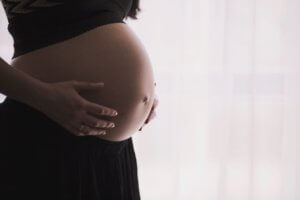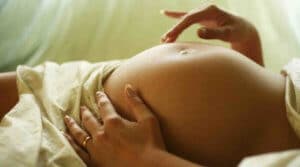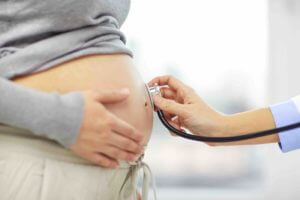Most babies are born with the cranial position. This means that the head precedes the birth. In most cases, the baby turns in the
34th week of gestation to come into the world headfirst.
It slides further and further down. In breech presentation, the baby does not turn until the end of pregnancy.
You can find out what this means in this article.
What Is A Breech Presentation?
In a breech presentation, also called breech
presentation, the baby does not turn during pregnancy.
This means that at the end of pregnancy, he or she is lying in the womb with the breach facing down, rather than head down. A breech presentation occurs in about three to four percent of pregnancies.
This does not necessarily mean that your baby will be born by
cesarean section. Usually, doctors and midwives strive to deliver the baby from the vagina.
In some cases, a miracle happens just before delivery, so that the baby still thinks it over and turns.
Different Birth Positions In Breech Presentation
There are numerous birth positions. The most common birthing position is the cranial position, but there are also different positions.
The most common position is the anterior occiput position, but the face position, side position and other positions can also occur in the breech position. There is a great danger in a transverse position, in which the baby lies transversely in the womb until the end of pregnancy.
A cesarean section is always required to avert this danger to the mother and baby. In the breach or end of the pelvic position, the baby lies with the pelvis and often with the feet down.
A distinction is made here between different positions:
Pure Breech Presentation
In this position, the baby lies with the breech down and the legs are crossed upward. The feet are in front of the baby’s face.
Both legs are bent and the knees are on the baby’s belly.
One leg is bent and the other is turned up.
During birth, the feet go forward.
One leg extended downward and one leg turned up.
Perfect Knee Position
Both legs are bent, the baby kneels.
Imperfect Knee Position
The baby has one leg bent backward and one leg turned upward.
The most common form of breech presentation is pure breech presentation. The rarest form is the breech presentation. All forms of breech presentation are associated with risks to both mother and baby. The form of breech presentation can be crucial in determining whether it is possible to deliver a baby from the vagina.
What Are The Causes And Risks Of Breech Presentation?
Breech presentations can have a variety of causes. Often, multiple pregnancies are the cause. In multiple pregnancies, the babies may have different birth positions.
In a
twin pregnancy, both babies may be born in the cranial position or in the breech position, but also one baby may be born in the cranial position and one in the breech position.
In addition, there are many other causes of breech presentation, even if it is not multiple pregnancies:
- Premature birth, because the baby has not yet turned at the premature time of birth.
- Very large baby that has no room to turn in the uterus.
- Little amniotic fluid.
- Very much amniotic fluid.
- General inactivity of the baby, so he or she does not move much.
- Frequent movements of the baby.
- Very narrow uterus and abnormalities of the uterus.
- Narrow pelvis or pelvic anomaly.
- Unfavorable position of the placenta.
- Too short umbilical cord.
When Is It Time For The Baby To Turn?
To avoid complications for mother and baby, the pregnancy is closely monitored. With ultrasound examinations, but also by palpating the abdomen with the hands, the doctor or
midwife can determine whether it is a breech presentation.
The position of the baby only becomes interesting in the last third of pregnancy.
For some time after the
30th week of pregnancy, the baby can still turn. The baby mostly turns in the 34th or 35th week of pregnancy to see the light of day in the cranial position.
The length of the cranium does not matter. In some cases, the baby still turns shortly before birth. Now and then, the doctor tries an external turn to allow the birth baby from the vagina.
Often, expectant mothers do not notice whether the baby is in the uterus with its head or pelvis up. However, in a breech presentation, you can feel now and then if the head is up and if the baby is kicking in the lower part of the uterus.
What Are The Risks Of Breech Presentation?
In a breech presentation, although the aim is to deliver the baby from the vagina, there may be complications.
If the baby’s feet or bottom go first, the cervix often cannot open as well as when the baby is born head first. If the birth progresses, the umbilical cord is between the baby’s head and the mother’s birth canal.
Even though the length of the cranium plays a minor role, the head is the largest part of the baby. The umbilical cord becomes entrapped in the short term. This risk becomes even greater with
premature rupture of the membranes.
There may be a short-term undersupply of oxygen to the baby.
If the babies undersupply of oxygen is brief, complications do not occur. The situation is different if the undersupply is prolonged. It can lead to serious disabilities of the baby.
Due to the greater pressure on the baby’s skull in the breech presentation, brain hemorrhage can occur. The baby will need intensive medical monitoring following birth.
Plexus paralysis is also possible due to the more difficult birth process when the baby is born from the vagina. The nerves in the baby’s arm may be damaged. Paralysis in the arm may result.
In a breech position, the baby’s extremities can also become stuck, which can lead to complications.
Allow Birth Baby From Vagina By External Turning
To avoid complications during delivery and allow birth baby from the vagina, the doctor or midwife may try external turning. It is performed three to four weeks before the expected date of birth.
For absolute relaxation of the uterus, the mother is given a contraceptive. The doctor uses gentle pressure movements on the mother’s abdomen to try to turn the baby. If this succeeds, the baby does a somersault so that it is born in a cranial position.
The success rate for external turning is between 50 and 70 percent. The external turn is associated with risks. The prerequisite is that the baby’s heart tones are consistently monitored.
Monitoring is done with a labor recorder. It depends on the shape of the breech presentation how successful the turn is. This process takes about two and a half hours.
Complications can occur due to premature detachment of the placenta. Premature birth may occur. In case of complications, everything should be prepared for an emergency cesarean section.
How To Induce Your Baby To Turn Around By Yourself
You can try different methods to get the baby to turn in a breech presentation. There is no guarantee of success for this. Many of these methods are associated with various risks.
Indian Bridge
This is a type of
yoga where you lie with your head on the floor and your belly is higher than your head. You should keep your pelvis elevated for 15 minutes.
You can try the Indian bridge from the
32nd week of pregnancy. You should not do the Indian bridge alone, as it can lead to complications.
Acupuncture can be done from the
35th week. It should not be done before, as it can induce preterm labor. Acupuncture can be done three times at intervals of several days.
Foot reflexology can also make your baby turn.
Moxibustion
Moxibustion is a combination of acupuncture and heat.
A specific point on the pregnant woman’s feet is heated with a moxa stick made of mugwort herb. This treatment should not be used in case of preterm labor, as it may intensify the contractions.
Success cannot be guaranteed with any of these methods. Premature labor and premature
placental abruption may occur.
Now and then, attempts are made to reverse the baby with hypnosis, with a flashlight, or with sound balls. However, all of these methods are highly controversial. There is no scientific evidence for the flashlight or sound ball method.
Requirements For The Birth Baby From The Vagina In Breech Presentation
A cesarean section does not always have to be performed for breech presentation. However, it is necessary if complications are already to be expected before the birth or if complications occur during the birth of baby from the vagina.
For a birth baby from the vagina to be possible, several conditions must be met. The baby should not weigh more than 3,500 grams. The baby’s abdominal circumference should not be significantly smaller than the head circumference.
The length of the cranium is not relevant. As the abdomen emerges, the birth canal is stretched so that it does not take too long for the head to fully pass through the birth canal.
Within 20 to 60 seconds, the head should pass through the birth canal. With epidural anesthesia through the spinal cord, better relaxation of the mother is ensured.
Birth By Cesarean Section In Breech Presentation
Birth by cesarean section must be done when the conditions for birth baby from the vagina are not present. In the case of cesarean section, the risk for the mother is ten times higher than in the case of vaginal birth
However, it is important to minimize the risk to the baby in a breech presentation. A C-section is a routine procedure, but it can be quite stressful for the mother. If you have already had a C-section, it is not a risk for further births.
Breech Presentation: Conclusion
In a breech presentation, the baby does not turn until the end of pregnancy. There are different forms of breech presentation, which is also called breech presentation. The baby is born breech first rather than head first.
The external turn can be done by the doctor to turn the baby. Success is not guaranteed. There are risks associated with external turning.
Breech presentation can lead to complications because the umbilical cord can be pinched off. The birth baby from the vagina is sought, but various conditions are required.
If these conditions are not met, a cesarean section must be performed.
Sources
https://www.netdoktor.de/schwangerschaft/beckenendlage/
https://www.babyartikel.de/magazin/steisslage
https://www.gofeminin.de/schwangerschaft/geburt-in-steisslage-beckenendlage-s795282.html












